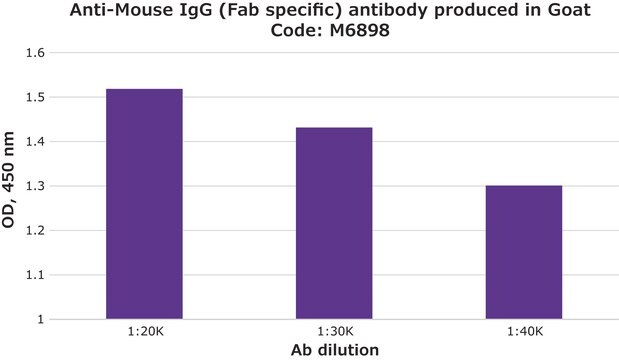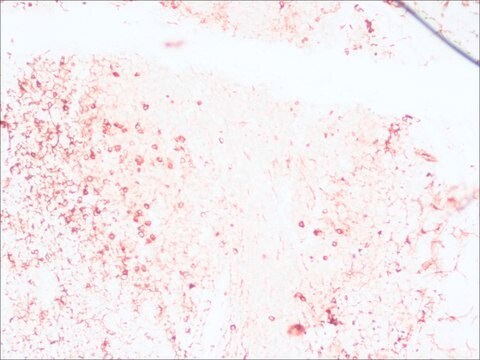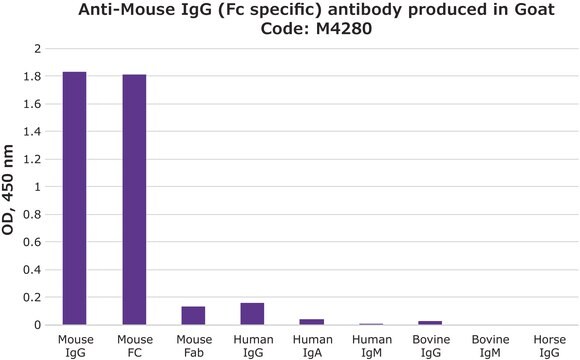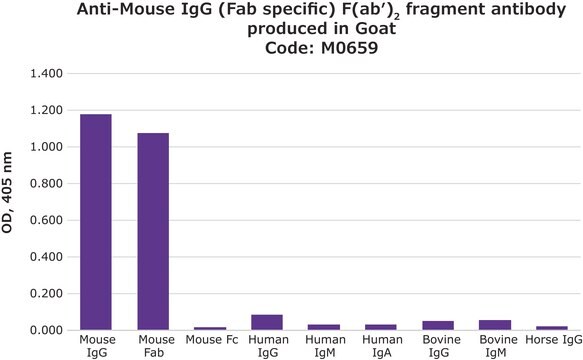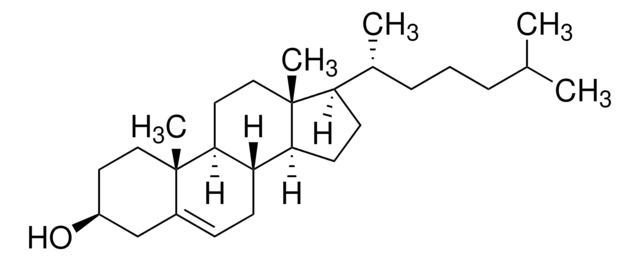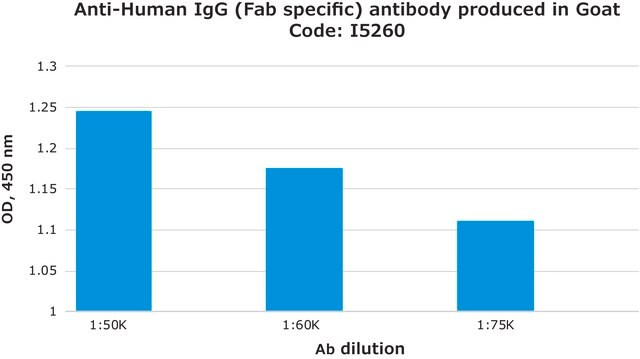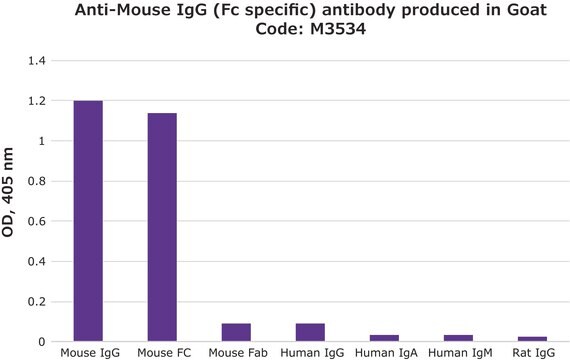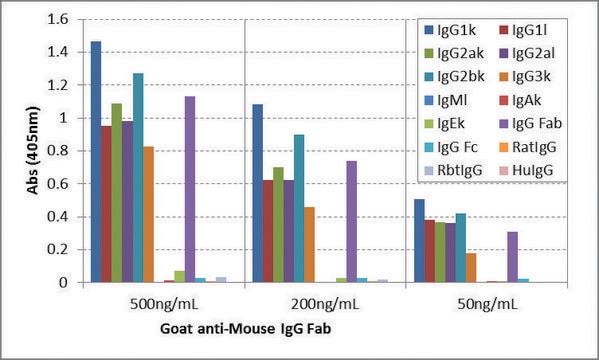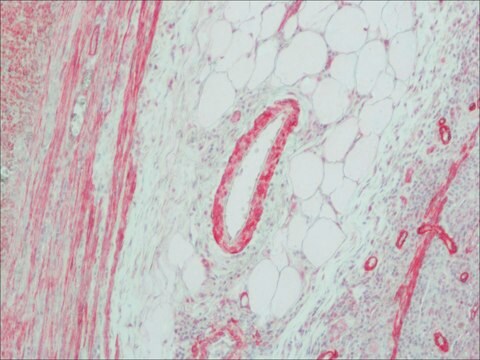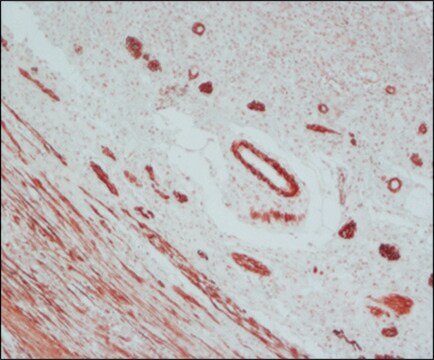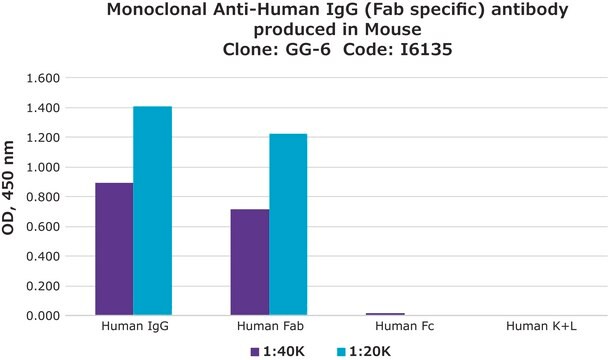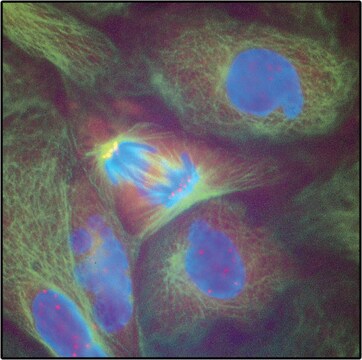추천 제품
생물학적 소스
goat
Quality Level
결합
unconjugated
항체 형태
affinity isolated antibody
항체 생산 유형
secondary antibodies
클론
polyclonal
농도
2.0 mg/mL
기술
Ouchterlony double diffusion: suitable
indirect ELISA: 1:15,000
배송 상태
dry ice
저장 온도
−20°C
타겟 번역 후 변형
unmodified
유사한 제품을 찾으십니까? 방문 제품 비교 안내
일반 설명
IgG consists of four polypeptide chains, made of two identical 50 kDa γ heavy (H) chains and two identical 25 kDa κ or λ light (L) chains, which are connected by inter-chain disulfide bonds. IgG has four isotypes IgG1, IgG2, IgG3 and IgG4.
애플리케이션
Anti-Mouse IgG (Fab specific) antibody produced in goat has been used in the expression and purification of human platelet factor 4 (PF4) and anti-PF4 monoclonal antibodies.
Anti-Mouse IgG (Fab specific) antibody produced in goat was used as secondary antibody in immunocytochemical staining at a dilution of 1:10.
생화학적/생리학적 작용
IgG activates the classical pathway of the complement system. It neutralizes virus particles and toxins. IgG plays a critical role in antibody-dependent cell-mediated cytotoxicity (ADCC). It has the longest serum half life and might be associated with allergy.
IgG antibody subtype is the most abundant of serum immunoglobulins of the immune system. It is secreted by B cells and is found in blood and extracellular fluids. It provides protection from infections caused by bacteria, fungi and viruses. Maternal IgG is transferred to fetus through the placenta that is vital for immune defense of the neonate against infections.
기타 정보
Antibody adsorbed with bovine, equine and human serum proteins.
물리적 형태
Solution in 0.01 M phosphate buffered saline, pH 7.4, containing 15 mM sodium azide.
면책조항
Unless otherwise stated in our catalog or other company documentation accompanying the product(s), our products are intended for research use only and are not to be used for any other purpose, which includes but is not limited to, unauthorized commercial uses, in vitro diagnostic uses, ex vivo or in vivo therapeutic uses or any type of consumption or application to humans or animals.
적합한 제품을 찾을 수 없으신가요?
당사의 제품 선택기 도구.을(를) 시도해 보세요.
Storage Class Code
12 - Non Combustible Liquids
WGK
WGK 2
Flash Point (°F)
Not applicable
Flash Point (°C)
Not applicable
이미 열람한 고객
S Peller et al.
Genes, chromosomes & cancer, 21(1), 2-7 (1998-01-27)
The TP53 gene has been extensively studied in patients with chronic myeloid leukemia (CML), both in chronic phase and in blast crisis. Mutations in the gene were found in up to 30% of the patients, especially among those in blast
Distinct Specificity and Single-molecule Kinetics of the Interaction of Pathogenic and Non-Pathogenic anti-Platelet Factor 4/Heparin Antibodies with Platelet Factor 4
Litvinov RI, et al.
The Journal of Biological Chemistry, jbc-M113 (2013)
Joong Ho Shin et al.
Journal of agricultural and food chemistry, 66(1), 290-297 (2017-12-05)
This paper presents a handheld device that is capable of simplifying multistep assays to perform sensitive detection of foodborne pathogens. The device is capable of multiplexed detection of Escherichia coli (E. coli) O157:H7, Salmonella Typhimurium (S. Typhimurium), Staphylococcus aureus, and Bacillus
Zheng Cai et al.
Nature communications, 6, 8277-8277 (2015-09-24)
Heparin-induced thrombocytopenia (HIT) is an autoimmune thrombotic disorder caused by immune complexes containing platelet factor 4 (PF4), antibodies to PF4 and heparin or cellular glycosaminoglycans (GAGs). Here we solve the crystal structures of the: (1) PF4 tetramer/fondaparinux complex, (2) PF4
Rustem I Litvinov et al.
The Journal of biological chemistry, 288(46), 33060-33070 (2013-10-08)
Heparin-induced thrombocytopenia (HIT) is a thrombotic complication of heparin therapy mediated by antibodies to complexes between platelet factor 4 (PF4) and heparin or cellular glycosaminoglycans. However, only a fraction of patients with anti-PF4-heparin antibodies develop HIT, implying that only a
자사의 과학자팀은 생명 과학, 재료 과학, 화학 합성, 크로마토그래피, 분석 및 기타 많은 영역을 포함한 모든 과학 분야에 경험이 있습니다..
고객지원팀으로 연락바랍니다.